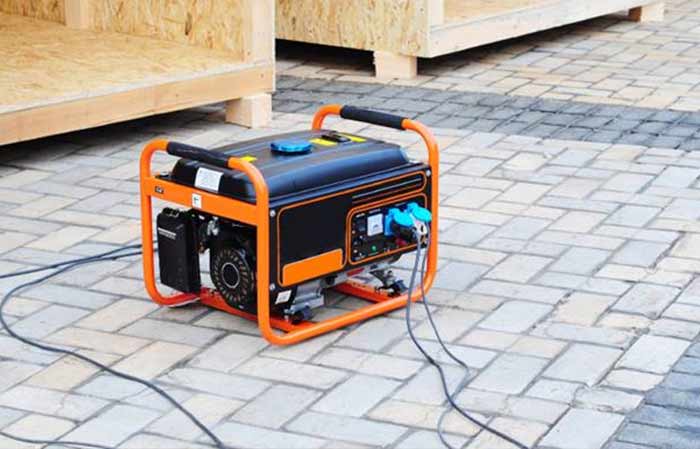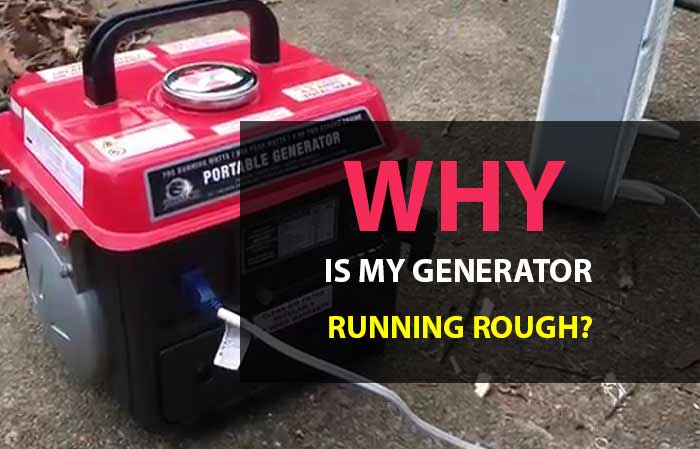When starting a generator, the sound usually starts off rough then smoothens itself out as the generator becomes stable. Other times, however, the generator might start off rough and remain that way until you shut it down or it goes off by itself. You may also notice the rough running suddenly while the generator was running just fine.
This occurs due to a long list of causes most of which we shall detail out in the following sections. Their respective solutions are also offered although you should only attempt carrying them out if you know what you’re doing.
Unless you’re a generator mechanic and know your way around most generator models, we advise that you always have the manual to your generator on hand to check what parts we’ll be referring to and how to handle them.
Causes of Generator Running Rough + Fixes
Some of the reasons why your generator isn’t running smoothly include the following:
1. Faulty carburetor
One of the most important parts of your generator is the carburetor. This is the part where fuel is mixed with air then channeled into the combustion chamber for ignition. It determines the ratio of fuel and air that is just enough to ignite and produce the needed power.
If faulty, the carburetor fails to properly mix fuel and air and may lead to the generator running rough. It’ll be characterized by high and low notes where the high notes denote the engine running well while the low ones indicate poor running.
The reason for this can be a clog in the carburetor with either air or fuel or both being blocked from reaching the carburetor. In such a case, the generator only runs with a little fuel and may even shut down eventually.
Clogs, blockages and the general failure of the carburetor can occur due to leaving fuel in the system for long. The fuel absorbs moisture from the air and turns stale. It thus won’t ignite properly. Also, the sediments in the stagnant fuel may cake up and block the carburetor vents.
Solution
Establishing issues with the carburetor requires removing it from the generator then checking its parts. You should test its electric circuits, valves and the pipes leading to it. If you find any issues, fix them accordingly. After that, clean and reinstall it on the generator then start the engine again.
There are problems which may not be fixed with simple repair and will require a completely new carburetor. Make sure you go for a quality one preferably the same type as the one you removed from the generator.

2. Clogged fuel filter
The fuel filter ensures only debris-free fuel reaches the carburetor and combustion chamber by sieving dirt out of the fuel. With time, the dirt builds up and clogs up the sieves. This reduces the amount of fuel reaching the carburetor.
One of the signs that the fuel filter is clogged is the rough running of the generator. This occurs since the carburetor will be getting intermittent amounts of fuel. As more debris builds up in the filter, the generator may just shut down.
Solution
After the generator has cooled off when you shut it down, you should check the fuel line coming out of the fuel filter. Keep the fuel valve open for this exercise. If it’s not a steady flow, it means the filter isn’t in good working condition.
Shut off the fuel valve then remove the fuel filter from the generator for cleaning. Do not clean with water but instead use petrol (the same type used to run the engine). Dry it then reinstall it and run the generator.
3. Malfunctioning spark plug
The spark plug is the part that provides the spark to ignite the mixture of air and fuel in the combustion chamber. It does this by passing an electric current to the air/fuel mixture. The resulting explosion is what powers the engine.
If the spark plug is malfunctioning in any way, it’ll not spark consistently, and the engine will thus run roughly. This can be due to cracks on the porcelain insulator, a burned electrode or carbon buildup on the electrode.
Solution
The solution to this issue is first checking the physical integrity of the spark plug. Open the cover to the plug then unscrew it from the body of the generator. The first thing to check should be the physical attributes. Check for cracks and dirt on the electrode.
For cracks, you’ll need a new spark plug as they can’t be fixed. For dirt, you can easily clean it using a knife or other blade then wash with petrol. Dry it then reinstall it on the generator.
Next, check whether the electrode is burned or not. While you can use a spark plug tester for this chances are high that you don’t have one at hand. The simplest way to do so is by connecting the plug to the electric circuit on one end then touching the other end on the crankcase of the generator while the engine is cranking. A strong blue spark indicates that the plug is in good condition. A weak one (or lack of spark) indicates that you need to replace the plug.
4. Overload
Overloading a generator occurs when it’s supplying less power than the electronics connected require. This makes it hard for the generator to run smoothly since it tries to match the power needed but its capacity doesn’t allow it.
Solution
While the generator is still running, shut off some electronics connected to the power from the generator then gauge if the sound changes or not. Keep reducing the load until the generator stabilizes its roar. If this isn’t the case, it means it’s another issue and not an overload.
To prevent this type of problem, always buy a generator with a higher power rating than what your home needs. At least 1.5 times your power needs is enough since adding new electronics will not overload it.
5. Stale fuel
If your generator has had fuel for more than a month and not used it up, chances are high that the fuel will be stale. The ethanol in the fuel absorbs water from the air thus reducing its efficiency as a fuel. Some other parts of the fuel evaporate thus reducing its efficiency. The same occurs if you had fuel in a can for more than a month and used it to fuel the generator.
Solution
The only solution to stale fuel in the generator is draining it and replacing it with fresh fuel. To prevent this, always run your generator at least once every month for about 3 hours each time. This ensures that the fuel in the generator is used up.
While it’s good to have a can of gas on hand for emergencies, never let it stay in the can for more than a month. Having an airtight can will help keep the fuel fresh for longer but it’s a major safety hazard since petrol is easily affected by ambient pressure and temperatures and might explode if sealed too tightly.
If there isn’t a way to run the generator within a month, use a fuel stabilizer with your fuel. This is a liquid which you’ll add to the fuel to keep it fresh for longer. It’s not a permanent solution but a good way to ensure your fuel doesn’t go to waste when you come back to use the generator after a long time.
If you’re using a fuel stabilizer, add it to the fuel tank then run the engine for about 10 minutes for the stabilizer to properly mix with the fuel and also reach the carburetor.
Any one of these issues will make your generator run rough. You may even notice a fluctuation in the output of power such as lights that dim then go bright momentarily. Whenever the generator starts running dry, disconnect the power output cables to ensure your electronics aren’t fried.
Tips to prevent rough running
To prevent this issue, follow the tips below:
- Don’t let the generator stay for more than a month without running the engine for a while. This prevents the buildup of stale fuel.
- If you can’t run the generator for over a month, choose to add a fuel stabilizer to it. Run it for about 10 minutes for the fuel stabilizer to reach all parts of the fuel system.
- Always check the various valves on the generator and make sure they’re in the right setting. This is especially true for the fuel valve.
- Also check all the levers of the generator such as the choke and others to make sure they’re also in the right position.
- Avoid overloading the generator by only using electronics that add up to an electric load below the generator’s maximum output.
- Always make it a routine to check the fuel filter and the air filter to ensure they’re in good working condition.
- Service the generator periodically to identify any issues that may be developing before they become major ones.
With these tips, your generator should be running smoothly each time it’ll be in use.
More Generator How-tos & Hacks
- Generator Won’t Start (New & Used): Causes, Troubleshooting & Fixes
- Generator Pull Cord Won’t Retract: Causes & Fixes
- How to Start a Generator: New, Used, With/Out Pull Cord
- Generator Won’t Stay Running: Causes & Fixes
- How to Connect /Hook Generator to House without Transfer Switch
- How to Change Oil in Generator-Step by Step
- How to Clean Generator Air Filter & Housing
- How to Fix an Overloaded Generator
- How to make a Generator Quiet as a Cricket for Camping
- 15+ ways to Secure Portable Generators from Theft & Damage
- Portable Generators Safety Tips Checklist
- How to make a Generator Safe for your Electronics
